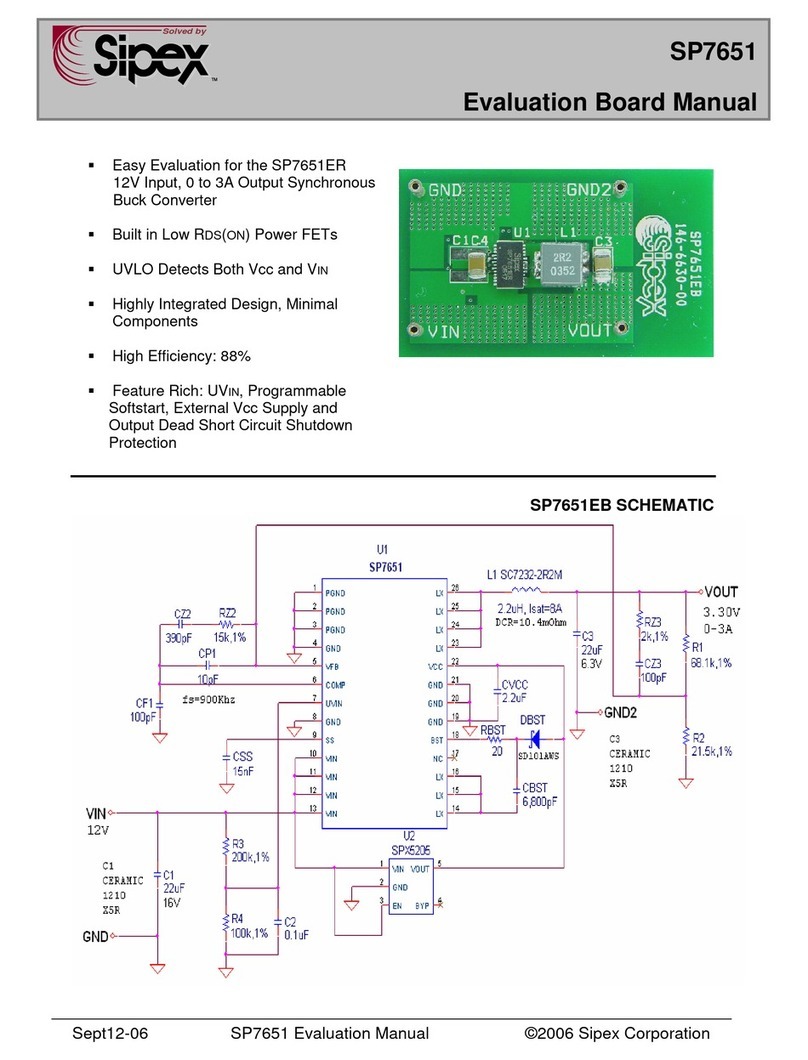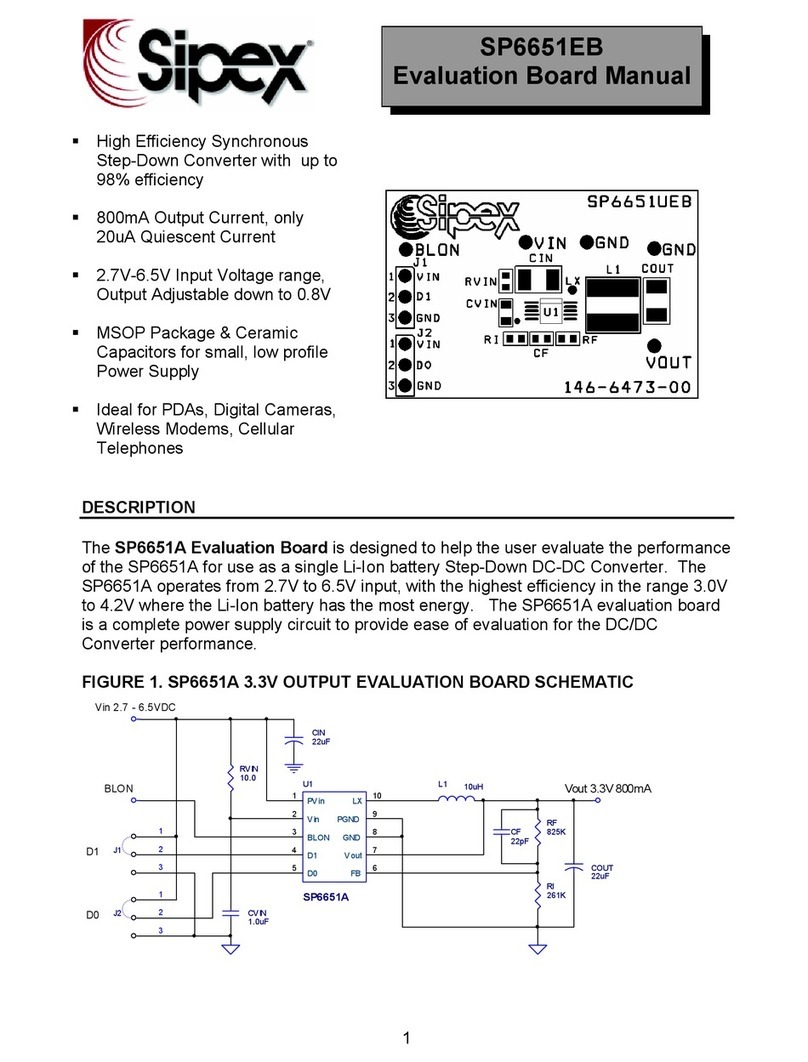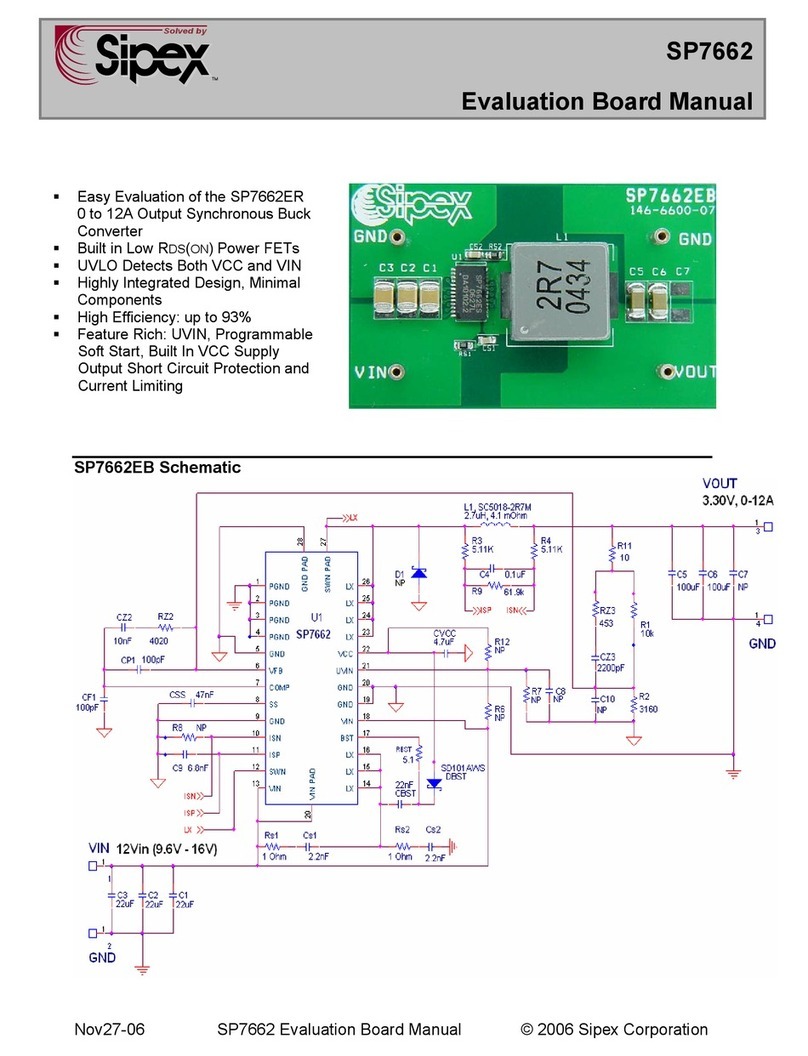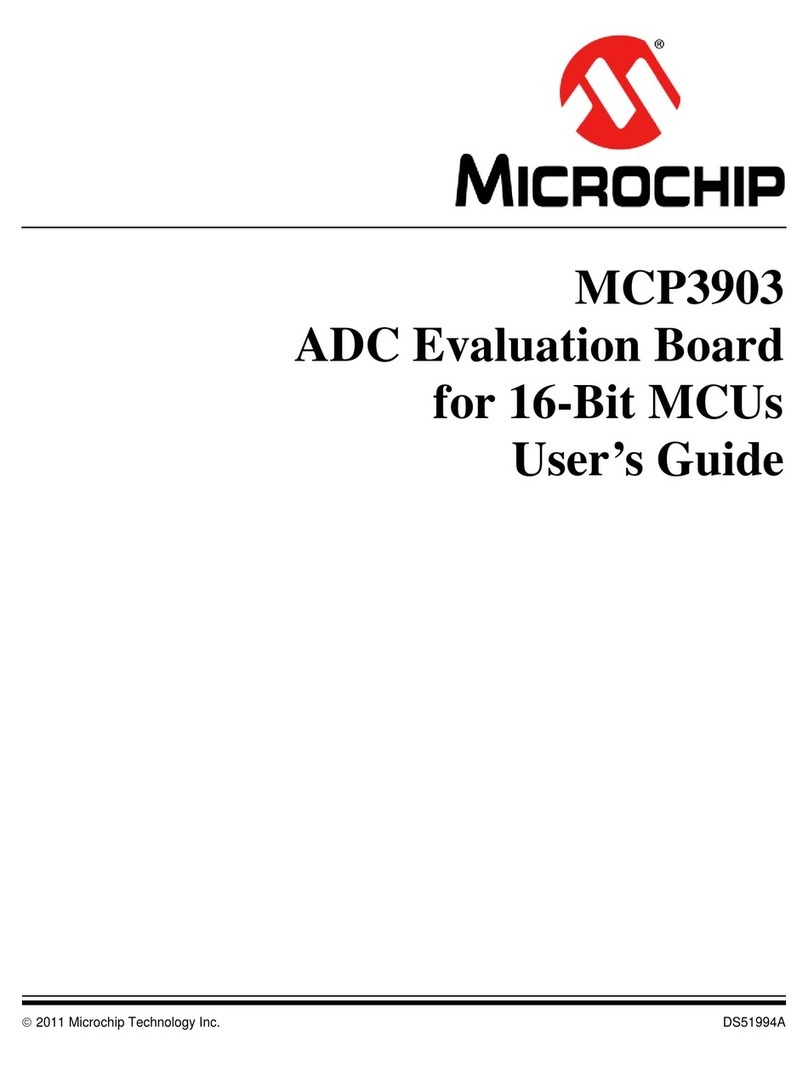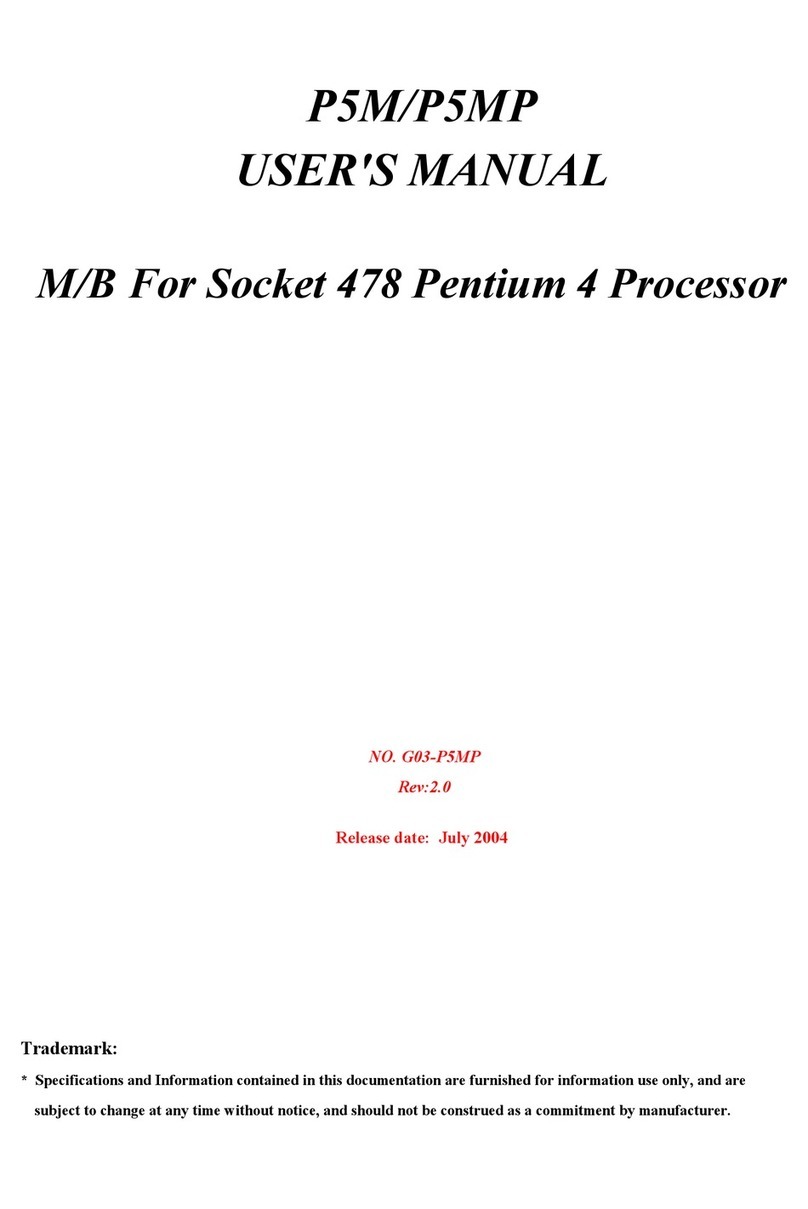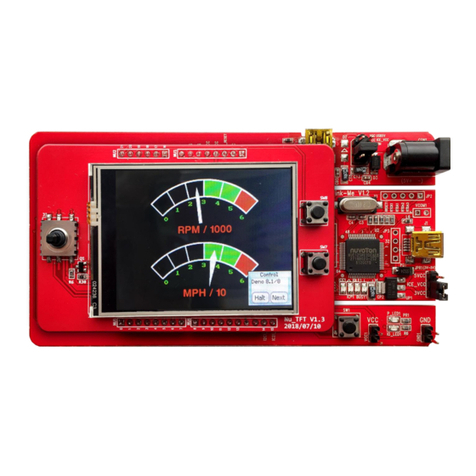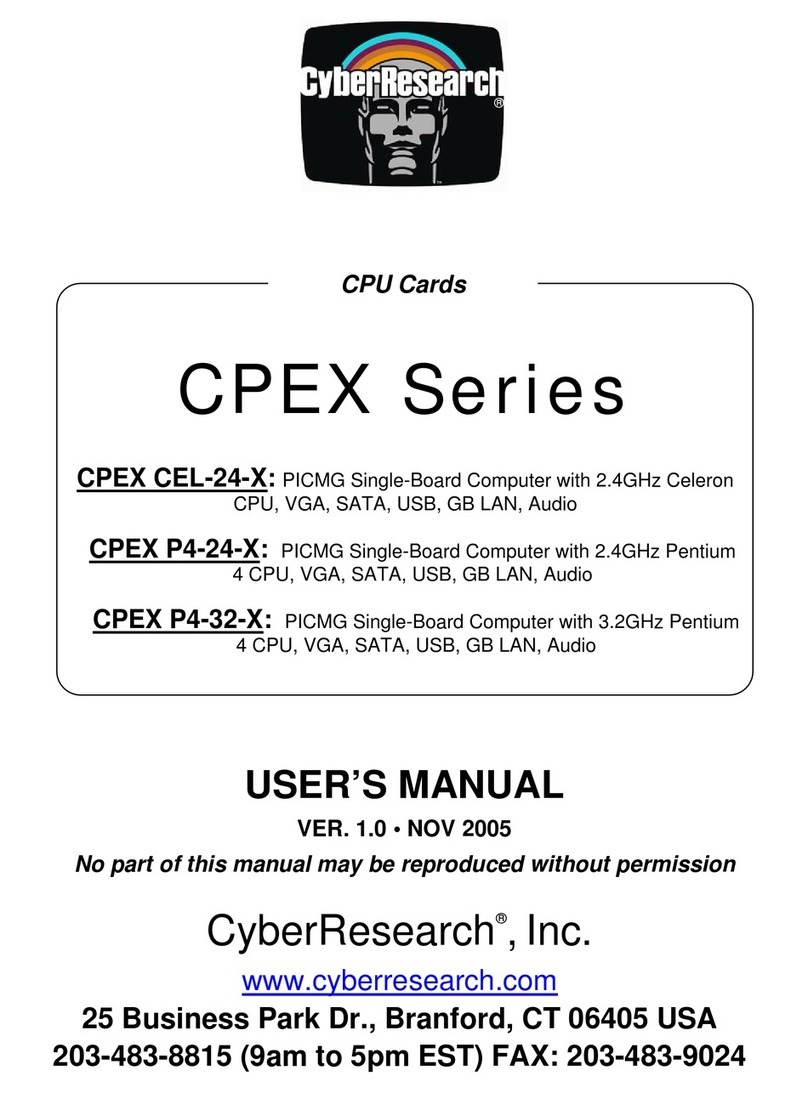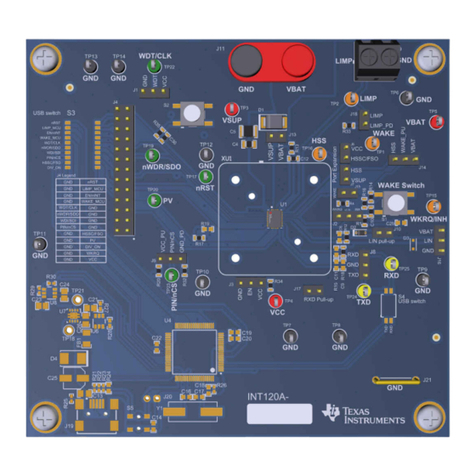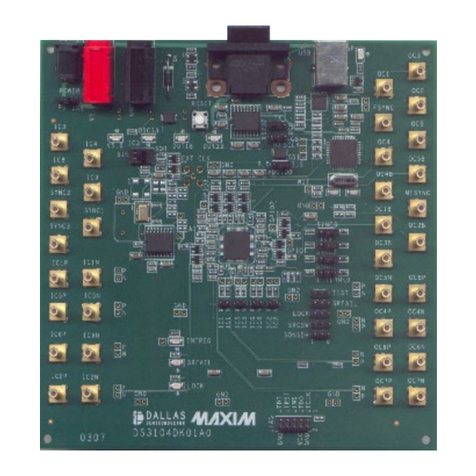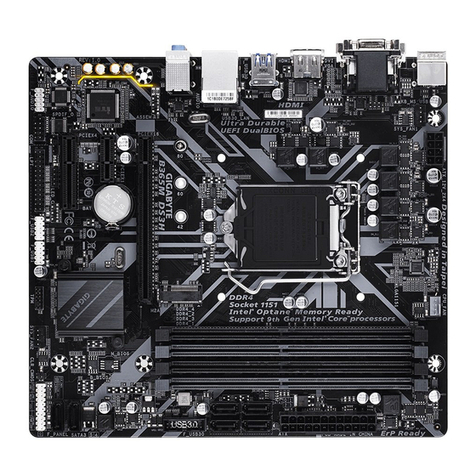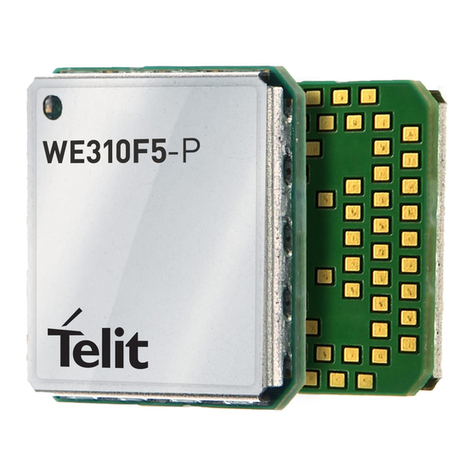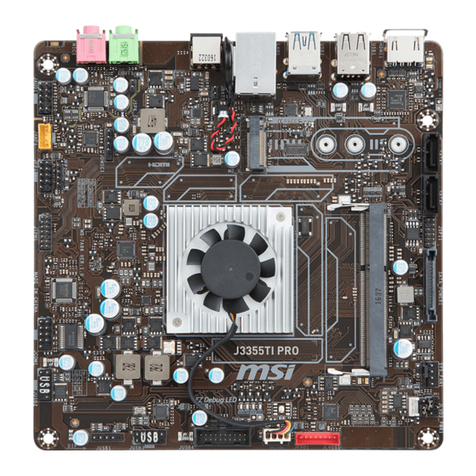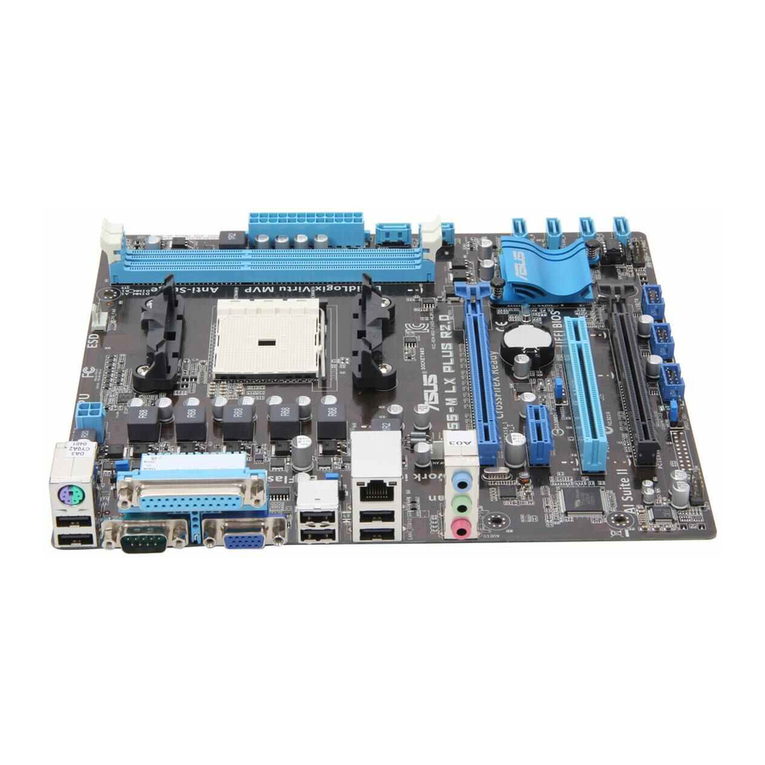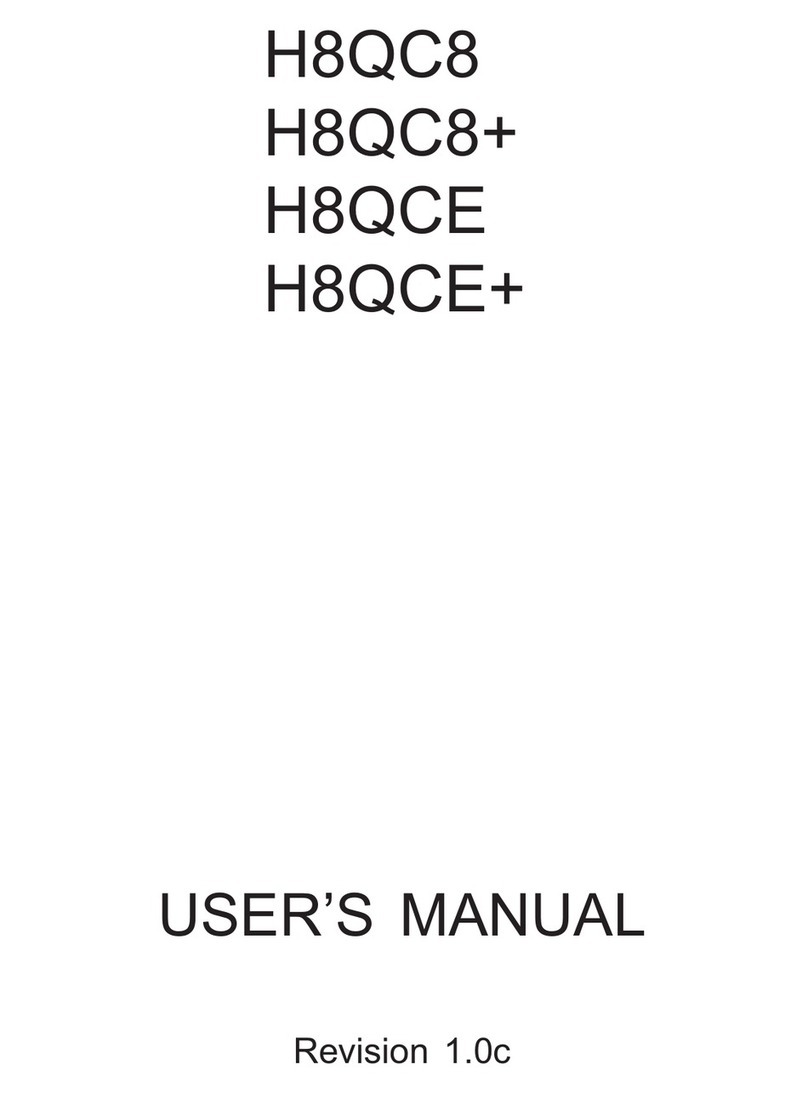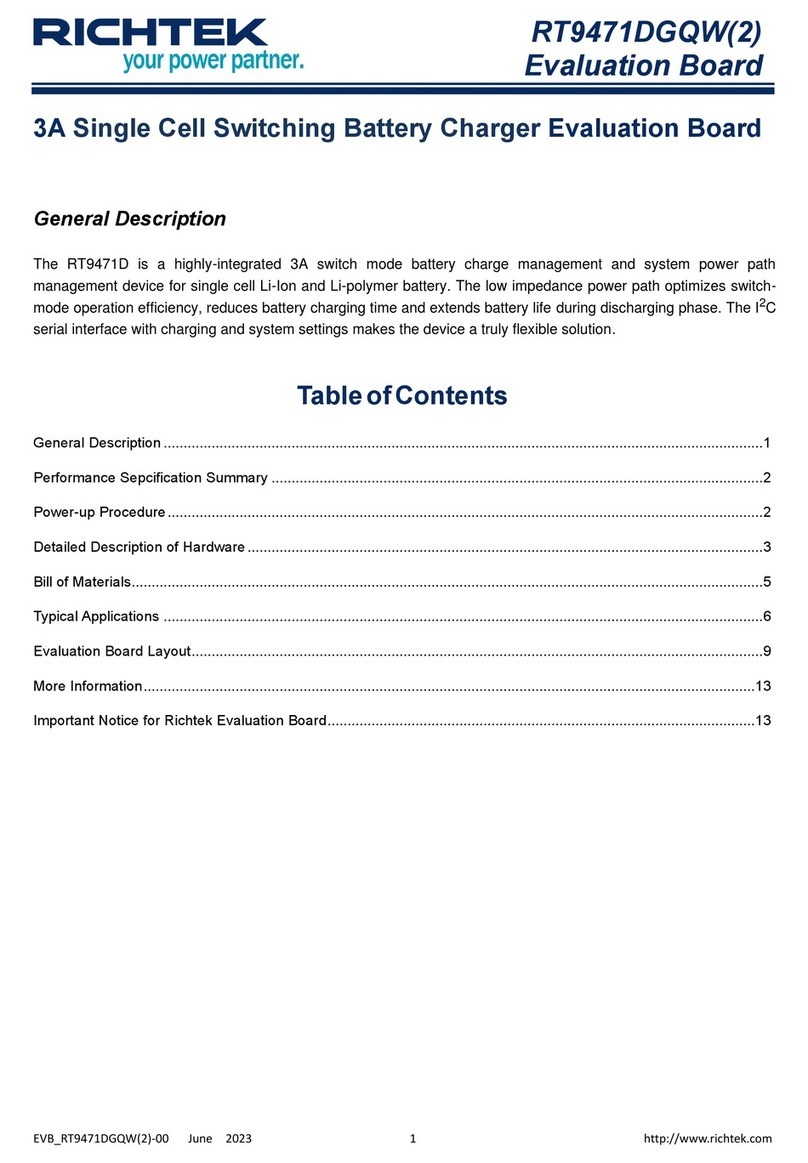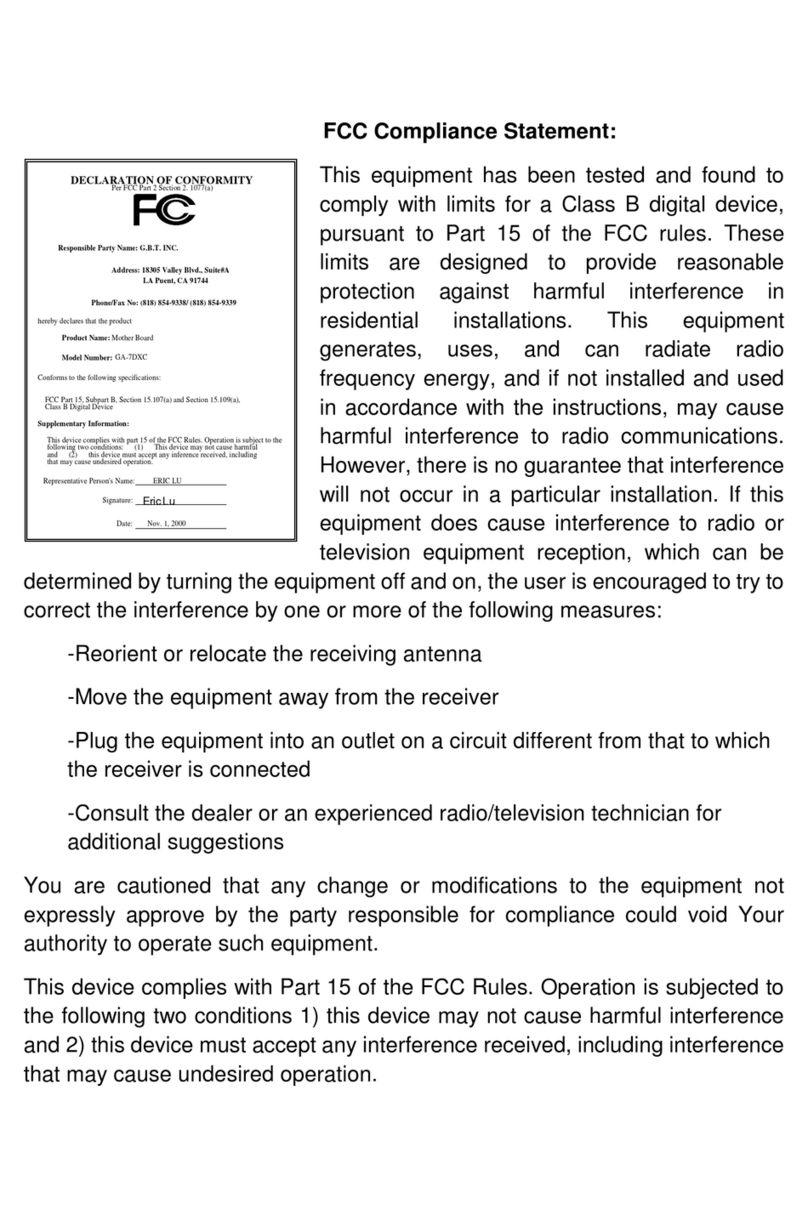Sipex SP7650 User manual

Date: 01/04/05 SP7650 Evaluation BoardManual Copyright 2005 Sipex Corporation
SP7650EB SCHEMATIC
12V
C1
CERAMIC
1210
X5R
16V
CBST
6,800pF
R3
200k,1%
L1
6.8uH
C1
22uF
CVCC
2.2uF
U1
SP7650
PGND
1
PGND
2
PGND
3
GND
4
VFB
5
COMP
6
UVIN
7
GND
8
SS
9
VIN
10
VIN
11
VIN
12
VIN
13 LX 14
LX 15
LX 16
NC 17
BST 18
GND 19
GND 20
GND 21
VCC 22
LX 23
LX 24
LX 25
LX 26
DBST
CSS
47nF
CP1
22pF
3.30V
0-3A
R2
21.5k,1%
GND
C3
22uF
C3
CERAMIC
1210
X5R
6.3V
VIN
SD101AWS
VOUT
RZ3
7.15k,1%
GND2
R4
100k,1% C2
0.1uF
CZ3
150pF
CZ2
1,000pF R1
68.1k,1%
RZ2
15k,1%
CF1
100pF
fs=300Khz
Vz=5.6V
1210
D1
BZX384B5V6
R6
464,5%
All resistor & capacitor size
0603 unless other wise specify
U1 Bottom-Side Layout should has
three Contacts which are
isolated from one of another, QT
& QB Drain Contact and
Controller GND Contact
Notes:
RBST
20
Easy Evaluation for the
SP7650ER 12V Input, 0 to 3A
Output Synchronous Buck
Converter
Built in Low Rds(on) Power FETs
UVLO Detects Both VCC and VIN
High Integrated Design, Minimal
Components
High Efficiency: 90%
Feature Rich: UVIN, Programmable
Softstart, External VCC Supply and
Output Dead Short Circuit Shutdown
SP7650
Evaluation Board Manual

2
USING THE EVALUATION BOARD
1) Powering Up the SP7650EB Circuit
Connect the SP7650 Evaluation Board with an external +12V power supply. Connect
with short leads and large diameter wire directly to the “VIN” and “GND” posts. Connect
a Load between the VOUT and GND2 posts, again using short leads with large
diameter wire to minimize inductance and voltage drops.
2) Measuring Output Load Characteristics
It’s best to GND reference scope and digital meters using the Star GND post in the
center of the board. VOUT ripple can best be seen touching probe tip to the pad for C3
and scope GND collar touching Star GND post – avoid a GND lead on the scope which
will increase noise pickup.
3) Using the Evaluation Board with Different Output Voltages
While the SP7650 Evaluation Board has been tested and delivered with the output set
to 3.30V, by simply changing one resistor, R2, the SP7650 can be set to other output
voltages. The relationship in the following formula is based on a voltage divider from the
output to the feedback pin VFB, which is set to an internal reference voltage of 0.80V.
Standard 1% metal film resistors of surface mount size 0603 are recommended.
Vout = 0.80V ( R1 / R2 + 1 ) => R2 = R1 / [ ( Vout / 0.80V ) – 1 ]
Where R1 = 68.1KΩand for Vout = 0.80V setting, simply remove R2 from the board.
Furthermore, one could select the value of R1 and R2 combination to meet the exact
output voltage setting by restricting R1 resistance range such that 50KΩ≤R1 ≤100KΩ
for overall system loop stability.
Note that since the SP7650 Evaluation Board design was optimized for 12V down
conversion to 3.30V, changes of output voltage and/or input voltage will alter
performance from the data given in the Power Supply Data section. In addition, the
SP7650ER provides short circuit protection by sensing Vout at GND.
POWER SUPPLY DATA
The SP7650ER is designed with a very accurate 1.0% reference over line, load and
temperature. Figure 1 data shows a typical SP7650 Evaluation Board Efficiency plot,
with efficiencies to 90% and output currents to 3A. SP7650ER Load Regulation is
shown in Figure 2 of only 0.1% change in output voltage from no load to 3A load.
Figures 3 and 4 illustrate a 1.5A to 3A and 0A to 3A Load Step. Start-up Response in
Figures 5, 6 and 7 show a controlled start-up with different output load behavior when
power is applied where the input current rises smoothly as the Softstart ramp increases.
In Figure 8 the SP7650ER is configured for hiccup mode in response to an output dead
short circuit condition and will Softstart until the over-load is removed. Figure 9 and 10
show output voltage ripple less than 40mV at no load to 3A load.
While data on individual power supply boards may vary, the capability of the SP7650ER
of achieving high accuracy over a range of load conditions shown here is quite
impressive and desirable for accurate power supply design.

3
Efficiency vs Load
80
85
90
95
100
1.0 1.5 2.0 2.5 3.0
Load Current (A)
Efficiency (% )
Load Regulation
3.290
3.295
3.300
3.305
0.51.01.52.02.53.0
Load Current (A)
Output Voltage (V)
Figure 1. Efficiency vs Load Figure 2. Load Regulation
Figure 3. Load Step Response: 1.5->3A Figure 4. Load Step Response: 0->3A
Figure 5. Start-Up Response: No Load Figure 6. Start-Up Response: 1.5A Load
Figure 7. Start-Up Response: 3A Load Figure 8. Output Load Short Circuit
SoftStart
Vout
Ichoke (5A/div)
Vin=12V
Vout=3.3V
Vin=12V
Vout=3.3V
Vout
Vin
Iout (2A/div)
Vin=12V
Vout=3.3V
Iout (2A/div)
Vin=12V
Vout=3.3V
Vout
Vin
Vout
Vin
SoftStart
Iout
(
2A/div
)
Vout
Vin SoftStart
Iout
(
2A/div
)
Vout
Vin
Iout (2A/div)
SoftStart

4
+5V BIAS SUPPLY APPLICATION SCHEMATIC
In this application example, the SP7650ER is power by an external +5V bias supply
which current consumption of 20mA Maximum. If this supply is not available than it is
recommend Sipex SPX5205 Low-Noise LDO Voltage Regulator.
RBST
20
CBST
6,800pF
R3
200k,1%
L1
6.8uH
C1
22uF
CVCC
2.2uF
+5V
U1
SP7650
PGND
1
PGND
2
PGND
3
GND
4
VFB
5
COMP
6
UVIN
7
GND
8
SS
9
VIN
10
VIN
11
VIN
12
VIN
13 LX 14
LX 15
LX 16
NC 17
BST 18
GND 19
GND 20
GND 21
VCC 22
LX 23
LX 24
LX 25
LX 26
DBSTCSS
47nF
CP1
22pF
3.30V
0-3A
R2
21.5k,1%
GND
C3
22uF
C3
CERAMIC
1210
X5R
12V
6.3V
VIN
SD101AWS
GND2
VOUT
RZ3
7.15k,1%
R4
100k,1% C2
0.1uF
C1
CERAMIC
1210
X5R
16V
CZ3
150pF
CZ2
1,000pF R1
68.1k,1%
RZ2
15k,1%
CF1
100pF
fs=300Khz
Notes:
All resistor & capacitor size
0603 unless other wise specify
U1 Bottom-Side Layout should has
three Contacts which are
isolated from one of another, QT
& QB Drain Contact and
Controller GND Contact
Figure 9. Output Ripple: No Load Figure 10. Output Ripple: 3A Load
Table 1: SP7650EB Suggested Components and Vendor Lists
Vout ripple = 32mV
Vin
Ichoke(
2
A/div)
Vout ripple = 40mV
Vin
Ichoke (2A/div)

5
TYPE III LOOP COMPENSATION DESIGN
The open loop gain of the SP7650EB can be divided into the gain of the error amplifier
Gamp(s), PWM modulator Gpwm, buck converter output stage Gout(s), and feedback
resistor divider Gfbk. In order to crossover at the selecting frequency fco, the gain of
the error amplifier has to compensate for the attenuation caused by the rest of the loop
at this frequency. The goal of loop compensation is to manipulate the open loop
frequency response such that its gain crosses over 0dB at a slope of –20dB/dec. The
open loop crossover frequency should be higher than the ESR zero of the output
capacitors but less than 1/5 to 1/10 of the switching frequency fs to insure proper
operation. Since the SP7650EB is designed with Ceramic Type output capacitors, a
Type III compensation circuit is required to give a phase boost of 180°in order to
counteract the effects of the output LC under damped resonance double pole
frequency.
(SRz2Cz2+1)(SR1Cz3+1)
SR1Cz2(SRz3Cz3+1)(SRz2Cp1+1)
Vin
Vramp_pp
(SResrCout+1)
[S^2LCout+S(Resr+Rdc)Cout+1]
(R1+R2)
R2 OR Vout
Vref
Vout
(Volts)
Vref
(Volts)
Type III Voltage Loop
(Volts)
Vfbk
Gout(S)
Gain Block
Compensation Gamp(S)
PWM Stage Output Stage
Gain BlockGain Block
Gpwm
Gain Block
Gfbk
Voltage Feedback
Resr := Output Capacitor Equivalent Series Resitance
Definitions:
Rdc := Output Inductor DC Resistance
Vramp_pp := SP7650 Internal RAMP Amplitude Peak to Peak Voltage
Output Load Resistance >> Resr and Rdc
Cz2 >> Cp1 and R1 >> Rz3
Conditions:
Figure 11. Voltage Mode Control Loop with Loop Dynamic for Type III Compensation
The simple guidelines for positioning the poles and zeros and for calculating the
component values for Type III compensation are as follows:

6
a. Choose fco = fs / 10
b. Calculate fp_LC
fp_LC = 1 / 2π[(L) (C)] ^ 1/2
c. Calculate fz_ESR
fz_ESR = 1 / 2π(Resr) (Cout)
d. Select R1 component value such that 50kΩ≤R1 ≤100kΩ
e. Calculate R2 base on the desired Vout
R2 = R1 / [(Vout / 0.80V) – 1]
f. Select the ratio of Rz2 / R1 gain for the desired gain bandwidth
Rz2 = R1 (Vramp_pp / Vin_max) (fco / fp_LC)
g. Calculate Cz2 by placing the zero at ½ of the output filter pole frequency
Cz2 = 1 / π(Rz2) (fp_LC)
h. Calculate Cp1 by placing the first pole at ESR zero frequency
Cp1 = 1 / 2π(Rz2) (fz_ESR)
i. Calculate Rz3 by setting the second pole at ½ of the switching frequency and the
second zero at the output filter double pole frequency
Rz3 = 2 (R1) (fp_LC) / fs
j. Calculate Cz3 from Rz3 component value above
Cz3 = 1 / π(Rz3) (fs)
k. Choose 100pF ≤Cf1 ≤220pF to stabilize the SP7650ER internal Error Amplify
As a particular example, consider for the following SP7650EB with a Type III Voltage
Loop Compensation component selections:
Vin = 5 to 15V
Vout = 3.30V @ 0 to 3A load
Select L = 6.8uH => yield ≈40% of maximum 3A output current ripple.
Select Cout = 22uF Ceramic capacitor (Resr ≈4mΩ)
fs = 300khz SP7650 internal Oscillator Frequency
Vramp_pp = 1.0V SP7650 internal Ramp Peak to Peak Amplitude
Step by step design procedures:
a. fco = 300khz / 5 = 60khz
b. fp_LC = 1 / 2π[(6.8uH)(22uF)]^1/2 ≈15khz
c. fz_ESR = 1 / 2π(2mΩ)(22uF) ≈3.6Mhz
d. R1 = 68.1kΩ, 1%

7
e. R2 = 68.1kΩ/ [(3.30V / 0.80V) – 1] ≅21.5kΩ, 1%
f. Rz2 = 68.1kΩ(1.0V / 15V) (60khz / 15khz) ≈15kΩ, 1%
g. Cz2 = 1 / π(18kΩ) (20khz) ≈1,000pF, X7R
h. Cp1 = 1 / 2π(15kΩ) (3.6Mhz) ≈10pF => Select Cp1 = 22pF for noise filtering
i. Rz3 = 2 (68.1kΩ) (15khz) / 300khz ≈7.15kΩ, 1%
j. Cz3 = 1 / π(7.15kΩ) (300khz) ≅100pF, COG
k. Cf1 = 100pF to stabilize SP7650ER internal Error Amplify
+5V INPUT WITH A TYPE III COMPENSATION APPLICATION SCHEMATIC
Figure 12 shows another example of SP7650ER configures for +5V input by simply
changing a few external resistors and capacitors components value for delivering a 0-
3A output with excellent line and load regulation.
RBST
20
CBST
6,800pF
R3
100k,1%
L1
6.8uH
C1
22uF
CVCC
2.2uF
U1
SP7650
PGND
1
PGND
2
PGND
3
GND
4
VFB
5
COMP
6
UVIN
7
GND
8
SS
9
VIN
10
VIN
11
VIN
12
VIN
13 LX 14
LX 15
LX 16
NC 17
BST 18
GND 19
GND 20
GND 21
VCC 22
LX 23
LX 24
LX 25
LX 26
DBSTCSS
47nF
CP1
22pF
3.30V
0-3A
R2
21.5k,1%
GND
C3
22uF
C3
CERAMIC
1210
X5R
5V
6.3V
VIN
SD101AWS
VOUT
GND2
RZ3
7.15k,1%
C2
0.1uF
C1
CERAMIC
0805
X5R
6.3V
CZ3
150pF
CZ2
1,000pF R1
68.1k,1%
RZ2
15k,1%
CF1
100pF
All resistor & capacitor size
0603 unless other wise specify
fs=300Khz
Notes:
U1 Bottom-Side Layout should has
three Contacts which are
isolated from one of another, QT
& QB Drain Contact and
Controller GND Contact
Figure 12. SP7650ER Configures for Vin = 5V, Vout = 3.3V at 0-3A Output Load Current

8
PC LAYOUT DRAWINGS
Figure 13. SP7650EB Component Placement
Figure 14. SP7650EB PC Layout Top Side
Figure 15. SP7650EB PC Layout 2nd Layer Side

9
Figure 16. SP7650EB PC Layout 3rd Layer Side
Figure 17. SP7650EB PC Layout Bottom Side

10
Table 2: SP7650EB List of Materials
ORDERING INFORMATION
Model Temperature Range Package Type
SP7650EB…................................-40°C to +85°C...............…SP7650 Evaluation Board
SP7650ER..............................…. -40°C to +85°C.................................……26-pin DFN
-
00
8700
-
8700

Mouser Electronics
Authorized Distributor
Click to View Pricing, Inventory, Delivery & Lifecycle Information:
Exar:
SP7650EB
Table of contents
Other Sipex Motherboard manuals
